|
Chasing the Monsoon
... through Rajasthan
Text and photographs: Sanjay Singh Badnor
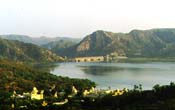 Sporadic downpours, interspersed with periods of bright sunshine don't allow me to plan an itinerary. I dash off to the various tourist
spots of the city as and when the weather permits. Sporadic downpours, interspersed with periods of bright sunshine don't allow me to plan an itinerary. I dash off to the various tourist
spots of the city as and when the weather permits.
My two days
in Jaipur are spent touring the forts of Amber, Jaigarh and Nahargarh,
the recently restored temple complex of Kanak Vrindavan, the city
palace museum, the Jantar Mantar Observatory, Jaipur's signature
building -- the Hawa Mahal (Palace of the Winds) and the grand
Rambagh Palace. Whew! There was so much to see... and only brief spells of sunshine.
Jaipur is also a major hub for Rajasthani handicrafts and a trip
to nearby Sanganer is obligatory. In fact, Sanganer is famous throughout
the country for its handmade paper and block printed fabrics.
Jaipur also offers blue pottery, enamelled jewellery, lac and
glass bangles, colourful tye and dye fabric and the special,
feather weight Jaipur quilts.
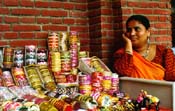 I embark on the third leg of my journey. Enroute from Jaipur to
Kota, I notice a dramatic change in the countryside; I have entered
the greener and more fertile belt of central and southern Rajasthan.
Out of the tinted windows of the cab, I look out on stretches of wheat and
corn fields, while the cabwallah cheerfully whistles songs of yesteryear
Indian films. I embark on the third leg of my journey. Enroute from Jaipur to
Kota, I notice a dramatic change in the countryside; I have entered
the greener and more fertile belt of central and southern Rajasthan.
Out of the tinted windows of the cab, I look out on stretches of wheat and
corn fields, while the cabwallah cheerfully whistles songs of yesteryear
Indian films.
A thunder storm engulfs us as we approach Tonk, a former Muslim
kingdom whose only remnant of glory is the Sunheri Kothi
(or gilded bungalow). A splendid edifice with polished floors, stained
glass windows, mirror panels and stucco and gilt-embellishment
combine to give it the look of a Venetian jewel box. But this gilded
mansion is in desperate need of repairs... otherwise it will
soon crumble to dust.
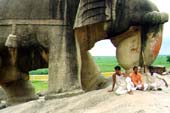 Just a few kilometres off the main Jaipur-Tonk-Kota highway lies the
small hamlet of Uniara, famous for the gigantic, larger-than-life
stone elephant carved out of a single rock. Known as Khera Hathi
Bhata or village of the stone elephant, it is a popular monsoon
picnic spot for nearby villagers. Just a few kilometres off the main Jaipur-Tonk-Kota highway lies the
small hamlet of Uniara, famous for the gigantic, larger-than-life
stone elephant carved out of a single rock. Known as Khera Hathi
Bhata or village of the stone elephant, it is a popular monsoon
picnic spot for nearby villagers.
By the time I spot the twinkling lights of the power station at
Kota across the river Chambal, it is already
late evening. I immediately head for the Umed Bhawan Palace, my
headquarters for the last two days of my monsoon sojourn.
Next morning, I familiarise myself with the Umed Bhawan Palace. Formerly the residence of the former Maharaos of Kota it is today
a splendid heritage hotel. Designed by Sir Swinton Jacob, it is a unique synthesis of the traditional and the modern.
Constructed by Maharao Umaid Singh, it remained the royal residence
till the present Maharao, Brijraj Singh, decided to convert it
into a luxury hotel.
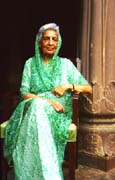 The Maharao now resides at Brijraj Bhawan, the picturesque
riverside, colonial-style palace overlooking the Chambal river.
However, his mother, the Rajmata of Kota, continues to stay in
one section of Umed Bhawan. Hailing from the royal family of Bikaner,
the octogenarian Rajmata, Shiv Kumari, is the daughter of the
illustrious Maharaja of Bikaner, the late Sir Ganga Singh. In
fact, her marriage to the late Maharao of Kota, Bhim Singh, in
1930, coincided with the completion of the Umaid Bhawan. The Maharao now resides at Brijraj Bhawan, the picturesque
riverside, colonial-style palace overlooking the Chambal river.
However, his mother, the Rajmata of Kota, continues to stay in
one section of Umed Bhawan. Hailing from the royal family of Bikaner,
the octogenarian Rajmata, Shiv Kumari, is the daughter of the
illustrious Maharaja of Bikaner, the late Sir Ganga Singh. In
fact, her marriage to the late Maharao of Kota, Bhim Singh, in
1930, coincided with the completion of the Umaid Bhawan.
The Rajmata graciously agreed to meet me over a cup of tea in
the well-appointed, private sitting room in her section of the
palace. Elegantly draped in an emerald green, printed French
chiffon sari, she talks of how she came here as a new bride and
how, in her subsequent years as Maharani, she played the role
of official hostess.
Kota may not have gained prominence as a tourist destination,
but its importance lies in the fact that it is Rajasthan's largest
industrial city. Now, along with Bundi and Jhalawar, it is fast
emerging as a new tourist spot.
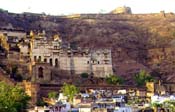 A torrential downpour begins, as I now make my way towards Bundi,
founded by the Hara branch of the Chauhan Rajputs in the 14th
century. It is a convenient day trip from Kota. Bundi, which is
rather medieval in character, is famous for its awesome fort atop
a 550 feet hill. The historian, Colonel Todd, rated it as one
of the finest in all Rajputana. A torrential downpour begins, as I now make my way towards Bundi,
founded by the Hara branch of the Chauhan Rajputs in the 14th
century. It is a convenient day trip from Kota. Bundi, which is
rather medieval in character, is famous for its awesome fort atop
a 550 feet hill. The historian, Colonel Todd, rated it as one
of the finest in all Rajputana.
By the time I return to Kota, the numerous rivers and rivulets
en route are in full spate owing to the heavy rains. Between Bundi
and Kota, I have to cross at least three bridges with dangerously
high, water levels; I nickname them 'the bridges of Kota country'.
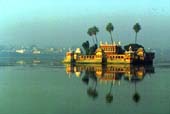 While at Kota, I visit the Rao Madho Singh museum in the Kota
city palace. It houses a rich collection of miniature paintings
from the Kota School of Art, besides proving to be a veritable
treasure house of artistic items used by the rulers of Kota. While at Kota, I visit the Rao Madho Singh museum in the Kota
city palace. It houses a rich collection of miniature paintings
from the Kota School of Art, besides proving to be a veritable
treasure house of artistic items used by the rulers of Kota.
Interesting too was the 18th century
Jag Mandir palace built smack in the middle of Lake Kishore Sagar for
a princess of Mewar who was married to a Kota prince and who began to
pine for the lake dotted environs of her native city of Udaipur.
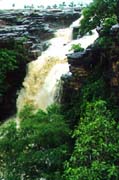 In the neighbourhood of Kota there were plenty of rather interesting places to see. I diligently covered each of them -- the ninth century temple complex at Baroli, the rock paintings
at Alaniya, the Darrah wildlife sanctuary, the imposing riverside
fort of Bhensrordgarh and the village of Kethun where the famous
Kota sari. Kota is also known for its grand and colourful Dusshera fair, an
annual fixture held in the months of October or November. In the neighbourhood of Kota there were plenty of rather interesting places to see. I diligently covered each of them -- the ninth century temple complex at Baroli, the rock paintings
at Alaniya, the Darrah wildlife sanctuary, the imposing riverside
fort of Bhensrordgarh and the village of Kethun where the famous
Kota sari. Kota is also known for its grand and colourful Dusshera fair, an
annual fixture held in the months of October or November.
My monsoon sojourn through Rajasthan ended at Kota. The next morning I was due to leave for Delhi... and return to my humdrum everyday existence. Before I left I had a chance to visit the waterfalls at Gaibbarnath near Kota. Spectacular! If you happen to visit Kota during the monsoon, make sure you do not miss these beautiful
waterfalls which can be seen along the gorges and ravines of the
river Chambal. It was a great finale to my monsoon trip.
Fact File
|

